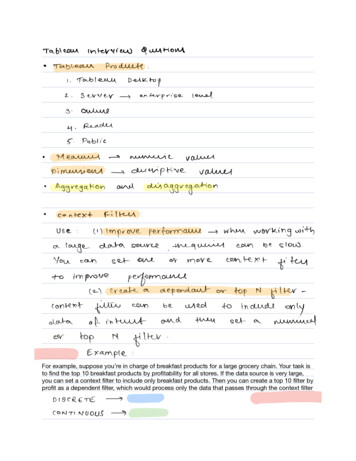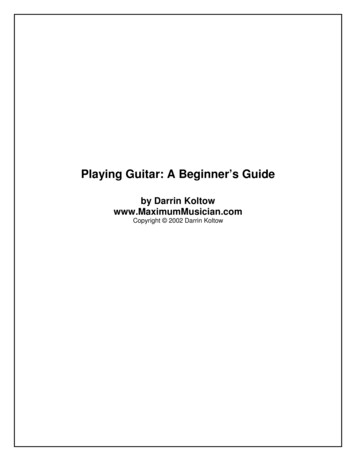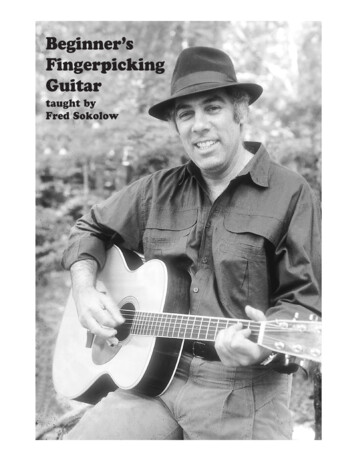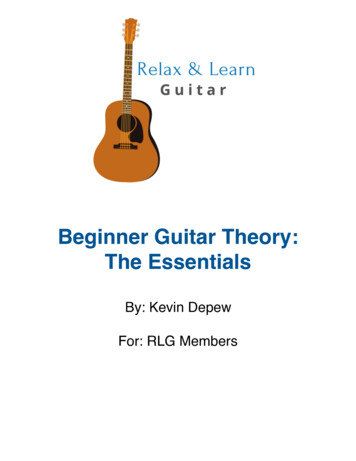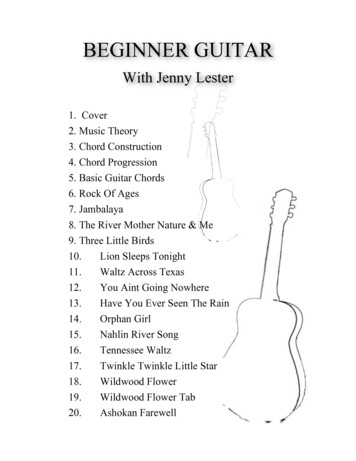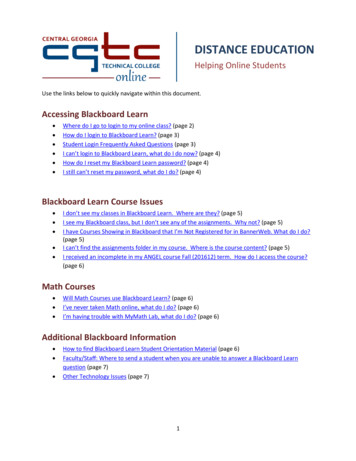
Transcription
YOU CAN LEARN GUITAR!BEGINNER GUITARCHEAT SHEET-Written by David Taub1
TABLE OF CONTENTS:LessonPageTable of Contents . 2Introduction. 3Ten essential points to remember. 4Parts of the guitar – acoustic & electric. 5Frequently asked questions, acoustic or electric? . 6Utilizing the pick . 7Names of the open strings . 8Three goals and you will be playing songs . 9Reading chord charts . 10Fret hand techniques – building a solid foundation. 11-12Learning your first chord . 13-14Learning your second chord. 15Learning your third chord . 16A few tips on practicing . 17-18Frequently asked question on practicing . 19Strumming and rhythm mechanics . 20Strum patterns. 21-22Another cool strum pattern. 23Another frequently asked question on practicing . 24Open position chords to learn . 25-26The F major chord. 27Chord chart and practice review . 28Chord changing techniques and principles . 29The shared fingers chord changing technique. 30Shared fingers chord change practice . 31The cluster principle chord changing technique. 32Cluster principle chord change practice. 33The slide principle chord change technique and practice. 34Techniques review . 35Notes on the Fretboard . 36-Written by David Taub, co-creator, Next Level Guitar Inc. Copyright Next Level Guitar Inc., 2014 - all rights reserved – unauthorized duplication ordistribution of any part of this book is prohibitedNEXT LEVEL GUITAR 2
INTRODUCTION:Hello good people! David Taub here and I would like to take a moment to thank you for your interestin my instructional products. I am so excited to get you started on your guitar journey. Whether youhave been playing for a little while or are just starting from scratch, I am totally confident that mylessons will help you achieve your guitar goals and get you playing the guitar and having fun.I think you will find that my teaching methods are of the best available on the market today. I havesuccessfully taught thousands and thousands of students both privately and online all over the world.I teach all levels, from students who have never touched a guitar, on through advanced players - so Irecognize the entire spectrum.Teaching a wide array of students allows me to see on a daily basis the common challenges that allstudents face when learning the instrument. This gives me unique insights on creating exercises andlesson plans to help students overcome these challenges and get them playing the guitar in thefastest and most efficient manner.So I know what works and what doesn’t, what students gravitate toward, what empowers students,and how to get students quickly moving forward on the instrument by achieving clear cut goals andobjectives - all while having FUN!Like with anything new and different, dive into these materials with an open mind. Know that if youpractice these techniques, work hard, and keep honing your skills and refining your art, thesemethods will bring results and you will be playing guitar like you always dreamed of.Guitar can be a challenging instrument for sure, but if you follow my structured curriculum, keep apositive attitude, and practice the right things, then you will succeed. The guitar will be something thatwill bring you joy for the rest of your life. The guitar is infectious and once you start reaping therewards you won’t want to stop. In fact you will probably be playing guitar for the rest of your life.Enjoy these materials and please let me know if you have any questions. I always welcome yourinsights and feedback as I am constantly tweaking my instructional products to make them the bestthey can be. You can email me at thenextlevelguitar@yahoo.comI wish you the best in all your musical endeavors.Enjoy the journey, and as always .ROCK ON!David Taubwww.nextlevelguitar.com .And please check out my full on video instructional website at www.nextlevelguitar.com3
TEN ESSENTIAL POINTS TO REMEMBER:1. Patience – Learning an instrument requires patience. Many of the techniques take time tomaster. Even fingering chords can be quite challenging. This is normal so do not getdiscouraged. It takes time to get your fingers, tendons, and muscles used to bending in theways necessary to play guitar. Take your time, be patient and it will come.2. Attitude – A positive attitude goes a long way. You can do this, so try and stay positive andremember that your guitar playing is an evolution.3. Proper technique – Utilizing the proper techniques and learning the proper fundamentals isessential for beginner guitar. Any bad habits that you start off with will be very hard to untanglelater as well as they will impede your progress down the road. So strive to follow the techniqueguidelines closely at first and then later down the road you can develop them into your ownpersonal style – first learn the rules, then go ahead and break them !.4. Fingernail length - Keep the fingernails on your fret hand short. If your nails are too long theywill interfere with the fretting of notes on the fingerboard. If you press straight down with onefinger on a solid surface, like a tabletop, and you feel the nail hitting the table before yourfingertip, your nails are too long and will need to be cut.5. Cleanliness - Wash and thoroughly dry your hands before picking up the guitar. It will keepoily residues and dirt off the fingerboard and your hands will be clean and not slide around onthe neck. Wipe the neck down with a soft cloth after playing as this keeps the neck clean andprolongs string life.6. On Discomfort - Fingertip soreness and wrist discomfort is normal for the beginning guitarist.As you play more your fingertip calluses will build up stronger and the discomfort will get lessand less. But if you feel major pain in the wrist or arm - STOP. Big pain is your bodies’ way oftelling you something may be wrong. Give it a little rest and go back to it later and check toensure you are utilizing the proper techniques.7. Slow down - Playing slow and in time is ALWAYS better than playing fast and sloppy. Alwaysmaster a concept at slow speeds before trying to play it faster. Speed comes with time.8. Notes on the neck – Not at first but eventually you want to try to memorize the notes on theneck and the notes that make up a given chord or a scale. You just don’t want to solely rely onjust fingerings or shapes. It will make you a better guitarist in the long run and you will be ableto speak “the language” of music when conversing with other musicians, writing songs, playingwith your friends, or in a band situation.9. Develop your ear – I say these words often, I feel developing your ear is one of the mostimportant things you can do as a guitarist or musician.10. Music theory - A little theory is a good thing. Not in the beginning but eventually putting timeinto learning some music theory has great value. It will move your playing forward faster andallow you to communicate the language of music to other musicians.11. Fun – Give yourself plenty of “fun time” on the guitar doing what you love to do best – learn asong, write a new tune, do fun stuff. Don’t spend all your time just studying and working newconcepts. HAVE FUN AND STAY POSITIVE – practice does not have to be drudgery!4
PARTS OF THE GUITAR – ACOUSTIC & ELECTRIC:In order to communicate effectively in guitar lingo you will need to learn some guitar terminology. Theillustrations below display some of the common parts of an acoustic guitar and an electric guitar.headstocktuning USTIC GUITARELECTRIC GUITAR5
FREQUENTLY ASKED QUESTIONSWhich guitar do I choose Acoustic or Electric?You have a choice when you start to learn to play guitar. Do you want to learn to play on the acousticguitar or on the electric guitar? The principles, concepts, and techniques that you will learn when firststarting to play guitar are the same no matter which one you choose.However, there are some basic differences between the two that I feel are very much worthmentioning. Your decision partially lies in which one sounds best to your ears and which one do youenvision yourself playing.Many of you will be drawn more to one than the other. You may want to have that electric guitarplugged in through an amplifier and eventually add distortion and rock out. Or, you may love and aremore drawn toward the beautiful sounds produced by a ringing, full-bodied acoustic guitar.Both instruments are truly wonderful and most guitar players eventually end up owning one of each, ifnot more. I have twelve guitars at this time and love them all – they are all unique and have their ownvoices.The biggest thing to keep in mind when making this decision is the electric guitar is a little easier tolearn on than an acoustic. On an electric guitar, the strings are of a lighter gauge, the action is lower,its easier to press down on the strings, and the body is thinner and easier to get your arm around. Sooverall the electric will be easier to play and learn on in the beginning.But learning first on an acoustic is fine, its just a little more challenging. Either way you want to findthe guitar that is the right fit for your hands and body and one that does not fight you. You want aguitar that is set up well and is easy to play. You will have enough to worry about at first just gettingover the physics of the instrument.Whatever guitar you go with make sure it’s the right fit for your body and hands. There are manydifferent model guitars on the market today. Some have wide necks and some thin, some have largebodies and some smaller. So finding the right sized guitar that fits your hands and body best, isabsolutely essential. The wrong sized guitar that is poorly set up and hard to play will increase yourfrustration level exponentially. Keep the variables to a minimum and get the right sized guitar.I suggest going with what you love. If you are drawn more toward the acoustic, and love that acousticsound – then go with that. You will probably end up having at least one of each down the line, andthen you will have the best of both worlds.6
UTILIZING THE PICK:There are basically two ways to attack the strings of the guitar. One way is with your fingers alone,which is called finger picking or fingerstyle guitar. Another way is utilizing a plectrum or what is morecommonly termed a pick.I want to get you playing the guitar in the fastest manner possible so lets start by utilizing the pick.Fingerstyle is indeed awesome, but the beginning techniques are very challenging and take a lot oftime to develop. I suggest starting off by using a pick and if you like that fingerstyle sound then that issomething you can study down the road after you have had some guitar time under your belt.Guitar picks come in various shapes, sizes, thickness, and materials. Various thickness picks willactually sound different as they hit the strings. As you get more familiar with the pick, you will want toexperiment. Try different materials and sizes to find what feels the best in your hands, AND soundsbest to your ears.I have found that beginning students gravitate more toward picks made from nylon that have raisedletters or ridges built into them. You don’t want the pick moving or sliding in your hand so you will findthe raised ridges or letters act like grips.Often beginners find the pick slipping in their hand as they strum, so a pick with grips on it comes invery handy. They also make picks with holes in them, this way part of your finger fits into that hole.This aids in gripping the pick so it does not twist or slide in your hand.Illustrated below are the two most common ways to hold the pick. Try them both and see which feelsbest in your hand.As
There are basically two ways to attack the strings of the guitar. One way is with your fingers alone, which is called finger picking or fingerstyle guitar. Another way is utilizing a plectrum or what is more commonly termed a pick. I want to get you playing the guitar in the fastest manner possible so File Size: 729KBPage Count: 36Explore furtherULTIMATE GUITAR SOLOING CHEAT SHEETwww.guitarjamz.comGuitar All-In-One For Dummies Cheat Sheet - dummieswww.dummies.comThe Ultimate Guitar Chord Chartimages.template.netGuitar Practice Cheat Sheet Downloadmy.guitarmasterymethod.comBeginners Guitar Chords - NuBeatnubeat.orgRecommended to you based on what's popular Feedback



